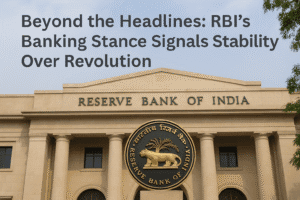Beyond the Headlines: RBI’s Banking Stance Signals Stability Over Revolution
RBI Governor Sanjay Malhotra firmly ruled out banking licenses for corporates, citing an “inherent conflict of interest” with entities controlling public deposits. Monetary policy remains neutral and strictly data-driven, prioritizing future inflation and growth projections over current low inflation figures. The central bank explicitly rejected reviewing the 26% promoter voting rights cap in private banks, emphasizing diversified ownership for essential checks and balances. While bank boards bear ultimate responsibility for operations, they cannot be liable for every minor lapse, though vigilance over depositor safety is paramount.
Efforts to internationalize the rupee continue pragmatically through bilateral trade deals (like UAE, Maldives), contrasting with stalled BRICS currency talks. Collectively, these stances underscore RBI’s unwavering commitment to depositor protection, systemic stability, and evidence-based decision-making over radical change or concentrated control.

Beyond the Headlines: RBI’s Banking Stance Signals Stability Over Revolution
The Reserve Bank of India (RBI), under Governor Sanjay Malhotra, has delivered a clear message: the core pillars of banking stability and depositor protection remain non-negotiable. Recent pronouncements, far from signalling radical change, reinforce a cautious, data-driven approach to navigating India’s complex financial landscape. Here’s the deeper meaning behind the announcements:
- The Corporate Banking Door Remains Firmly Shut (For Now): Governor Malhotra explicitly ruled out granting banking licenses to large corporate houses, either directly or through Non-Banking Financial Companies (NBFCs). This isn’t mere regulatory inertia; it’s a profound statement of principle. The RBI cited the “inherent conflict of interest” when a corporate group controls deposit-taking institutions – essentially playing with public money while pursuing its own commercial objectives.
- The Insight: This decision prioritizes systemic safety over potential efficiency gains. History globally (and specific Indian experiences) shows the catastrophic risks when conglomerates intertwine banking with their core businesses. The RBI is safeguarding the fundamental trust underpinning banking: that depositors’ money is ring-fenced from corporate ambitions. While the debate on corporate entry will continue, the RBI has anchored its position firmly in depositor protection.
- Monetary Policy: Navigating Uncertainty with a Neutral Compass: The Monetary Policy Committee’s (MPC) “neutral” stance isn’t indecisiveness; it’s strategic flexibility. Governor Malhotra emphasized future rate decisions will be strictly “data-driven,” focusing on the inflation and growth outlook 6-12 months ahead.
- The Insight: The RBI acknowledges the current puzzle. While headline inflation (2.1%) is comfortably below target, policy cannot react solely to the present. The key lies in future projections. The potential downward revision of Q4 inflation forecasts (from 4.4%) highlights this forward-looking approach. The message for businesses and borrowers? Don’t expect automatic cuts based on today’s number; the RBI is meticulously assessing the path ahead, balancing growth support against inflation risks that could re-emerge. Stability trumps knee-jerk reactions.
- Ownership & Governance: Stability Through Diversification and Vigilance: The RBI firmly shut down speculation about relaxing the 26% promoter voting rights cap in private banks, enshrined in the Banking Regulation Act. Malhotra underscored the importance of “diversification of ownership” to create essential “checks and balances within the owners.”
- The Insight: This isn’t about stifling promoters; it’s about preventing excessive, unchecked influence that could compromise sound banking practices or lead to misallocation of depositor funds. Diversified ownership is seen as a structural safeguard against concentrated risk. Simultaneously, Malhotra clarified governance responsibilities: while the Board holds “ultimate responsibility” for a bank’s operations, it cannot be micromanaged or held liable for “each and every misdemeanour.” Boards must, however, exercise vigilant oversight to ensure the safety of depositors’ funds – especially crucial for small depositors. This defines a realistic standard: strategic oversight, not operational nitpicking.
- Rupee Internationalization: Pragmatic Steps Over Grand Gestures: While talk of a common BRICS currency captures headlines, the RBI is focusing on tangible, incremental progress. Governor Malhotra highlighted the acceleration of rupee internationalization through bilateral trade settlements and currency agreements (e.g., UAE, ongoing talks with Maldives).
- The Insight: This reveals a pragmatic strategy. The RBI is building the rupee’s global role brick by brick through usable trade mechanisms and liquidity arrangements with key partners, rather than waiting for complex, politically fraught multilateral solutions like a BRICS currency (which Malhotra noted currently lacks momentum). It’s about enhancing trade efficiency and reducing dollar dependency step-by-step, grounded in operational reality.
The Underlying Narrative: Prudence as the Guiding Light
Governor Malhotra’s statements collectively paint a picture of a central bank deeply committed to its core mandates: price stability, financial system soundness, and depositor protection. In a world of economic uncertainty and clamour for rapid change, the RBI’s message is one of measured prudence:
- Depositors First: The rejection of corporate banking licenses and emphasis on board vigilance over depositor funds are direct affirmations of this priority.
- Data Over Dogma: Monetary policy decisions are deliberately unshackled from preset bias, relying instead on evolving economic realities.
- Stability Over Concentration: Maintaining diversified bank ownership is viewed as a bedrock of systemic resilience.
- Practicality Over Grandeur: Internationalizing the rupee is pursued through achievable bilateral channels rather than symbolic, complex multilateral ventures.
For businesses, investors, and the public, this signals a regulatory environment prioritizing long-term stability and risk mitigation. The RBI isn’t closing doors to future evolution, but it is ensuring that any steps forward are taken on a foundation of proven safeguards and careful analysis. In an era of flux, this steadfast commitment to core principles offers its own form of valuable certainty.
You must be logged in to post a comment.